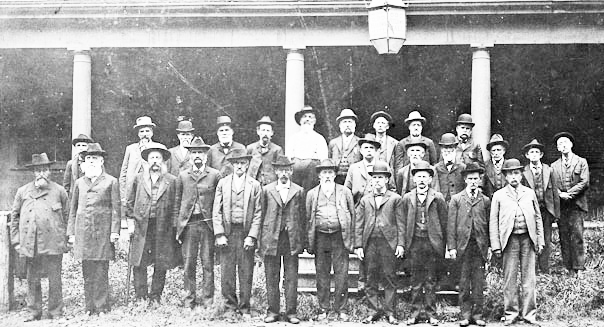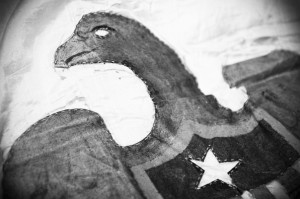True Tales: Remembering the Civil War
By George T. Comeau
Company A, the Canton men who were the first to leave Massachusetts in the Civil War, shown here at a reunion on September 17, 1898. (Photo by J.W. Wattles, Courtesy of the Canton Historical Society)
This story originally appeared in the Canton Citizen on May 5, 2011.
It may be cliché to say that you can touch history, but in all honesty, our history is made up of the places, artifacts and stories that we preserve for future generations to “touch.” Nowhere is this more evident than in the new exhibit at the Canton Historical Society that lays bare the artifacts brought back by Canton soldiers from the American Civil War.
Affectionately, I have always called the “Histy” Canton’s Attic. The building itself was completed 100 years ago and the Classical Revival building with a modest exterior holds thousands of photographs, artifacts and stories that create a link to our place here in Canton. The Historical Society has been collecting and preserving our history since 1871, when it was founded by a group of men to “obtain and preserve all material that would throw light upon the history of the town.” Many of these men fought in the Civil War, and they carefully placed their artifacts into the building for safekeeping.
It must have been with great pride in Canton and in our military role in the Civil War that prompted Wally Gibbs, the president of the society, to begin work on the current exhibit focusing on the Civil War. As Mr. Gibbs examined the holdings in the vault, and in musty drawers and boxes, he put together the story of war that is poignant and memorable. Each object selected is a direct connection to the intense hardship of battle and the bloody trials endured by our boys as they fought a war on home soil.
The history of Canton is intertwined with the Civil War. More than 600,000 men died in battle and even more would return home with disfiguring wounds on both their bodies and minds. Canton’s resident historian, James Roache, recounted the heavy loss of life from Canton: “In a town of almost 3,500 inhabitants, Canton would suffer the loss of 30 men in battle.”
The names of our lost men are inscribed on the memorial tablets that flank the interior at Memorial Hall. Our town hall is in fact a memorial to those who lost their lives in giving the ultimate sacrifice for freedom. The soldier who once stood outside Memorial Hall, and now is in a corner of the interior, was a tribute to the soldiers of Canton. Today, observe the patina of the statue, weathered and beaten, silently watching the tax collections and dog licenses.**
In the Canton Historical Society it is in the ordinary that we touch the extraordinary. There is the pewter plate used by Larra E. Wentworth in 1863. The Union canteen carried by Captain John Hall. And most touching is the simple tin plate that was picked up at Wilderness, Virginia, along the rebel lines. Buttons, belt buckles, and dress swords fill a case where time stands still and the battles have ended.
There are Union guns and Confederate rifles. The most interesting of these guns is the Confederate single-shot rifled musket that was taken from the battlefield at Bull Run. The rich, dark wood, smoothed by time, bears a rip from a Union bullet that tore the gun “from the hands of a South Carolinian rebel.” The force of the direct hit on the gun sent the weapon flying and wounded the rebel soldier. Attesting to the force of the shells are two bullets that met midair, united by the impact. The ammunition quieted but still telling tales.
Also long quieted is the bugle that belonged to Wallace McKendry. The son of Captain William McKendry and Harriet Billings, McKendry was born in Ponkapoag and enlisted in Company D 22nd Regiment and served as a sergeant in the Peninsular Campaign. The cloth cord and tassels are intact, and the owner’s name is simply engraved.
Most remarkably, the Histy owns the two dress swords worn by the grandsons of the patriot Paul Revere. These two men, Paul Joseph and Edward Hutchinson Robbins Revere, were heroes in the truest sense. Upon the call of duty, Paul Joseph Revere would leave a wife and two children. A dear friend urged him not to leave home, to which Revere remarked, “I have weighed it all, and there is something higher still. The institutions of the country – indeed free institutions throughout the world – hang on this moment.”

A detail of a captured Confederate flag on display at the Canton Historical Society (George T. Comeau photo)
The war stories surrounding the two Revere men from Canton are the stuff of movies, and sadly of life during war. Space precludes sharing the list of heroics as well as the tribulations. Suffice it to say that imprisonment, torture, hostage exchanges, glorious battles and, ultimately, sacrifice and death, paint a vivid portrait of the lives of these Cantonians. Both of these men represent the covenant with the Union and freedom, offering their lives to consummate the ideals of the United States of America.
The Revere men stand elegant in a large framed portrait above the door to the society vault that contains their military dress swords. Ask Wally Gibbs to see the swords, and touch a rare piece of Revere family history. Edward Revere’s sword is simple and tells the story of the surgeon who died heroically on the battlefield of Antietam on September 17, 1862. Colonel Paul Joseph Revere’s sword is engraved with the names of the battles in which he took part. Ball’s Bluff, Yorktown, West Point, Seven Pines, Fair Oaks, Peach Orchard, Savages Station, White Oak Swamp, Glendale, Malvern Hill, Antietam, and his final battle, Gettysburg. The names chill the air, and each battle brought him closer to death and into history for the name of his family and country. Mortally wounded on July 2, Paul Joseph Revere died at Gettysburg on July 4, 1863.
As if to punctuate the battles, there is the captured battle flag of the Confederate Army. In a hand-painted case the flag lies under glass. The 12 stars are faded, and the leather eagle slightly worn. The story behind this flag is found in a handwritten affidavit that reads: “This flag was captured by First Sergeant Edwin West of Wallace’s Zouaves 11th Indiana Regiment at the 3rd day fight – Battle of Shiloh.” The flag was claimed by West as to have been captured from the First Texas Calvary, taken from the hands of Colonel John O’Neil. In a letter of inquiry dated 1899, the last surviving Civil War veteran from Canton, John D. Billings, wrote to United Confederate Veterans and inquired as to Colonel John O’Neil’s whereabouts. The answer back was that O’Neil was not connected to the First Texas Calvary, but rather was a major, lt. colonel and colonel of the 10th Tennessee Infantry. O’Neil died in St. Louis, and perhaps along with him was the story behind the capturing of this flag. No matter, the flag is preserved and is a beautiful piece of our history.
Many of the items at the society, hundreds in fact, were collected by Colonel Billings. The notes that accompany the fragments of war indicate a man who was thorough and direct. Of the multitude of fragments from the war collected by Billings, we find such items as a piece of a scabbard picked up at Appomattox Courthouse, fragments of a shell found at Cold Harbor, and a tin cartridge case from Antietam. Billings lived until 1933, dying at age 91, and his passion for the war is evident by the breadth of his collection.
Sometimes the stories and connections to our nation’s past can be found in our own hometown, and the items on display are superb connecting points. I would invite you to visit the Historical Society and see these items on Monday, May 29, and let Wally Gibbs show you his display. Bring your children to hear the stories that make democracy and freedom possible. Take a friend along and come for the afternoon to discover your touch points to the war that began 150 years ago and ended slavery, creating a foundation for freedom for all men in America.
The Canton Historical Society will be open to the public from 9 a.m. to 12 noon on Memorial Day. The society’s exhibit of Civil War artifacts and other collections of Canton history will be on display.
**Thanks to the leadership of Canton Veterans Agent Tony Andreotti and funding from the Community Preservation Act, the Civil War soldier has since been restored and returned to its rightful place in front of Memorial Hall.
Short URL: https://www.thecantoncitizen.com/?p=36311










